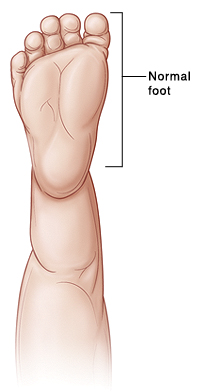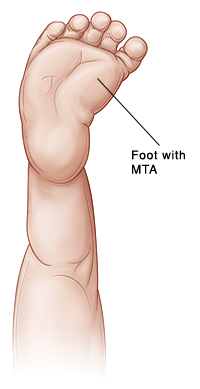When Your Child Has Metatarsus Adductus (MTA)
Your child was born with metatarsus adductus (MTA). This is a problem with the shape of the foot (deformity). The front part of the foot (called the forefoot) is hooked inward. The back part of the foot and ankle are normal. It is congenital, meaning your child was born with it. It may affect one or both feet. MTA is a common condition, causes no pain, and often goes away on its own.
|
| |
What causes metatarsus adductus?
MTA tends to run in families. In many cases, the position of the foot in the uterus during pregnancy contributes to development of MTA.
How is metatarsus adductus diagnosed?
MTA is easily diagnosed by looking at the foot when the child is born. The healthcare provider will differentiate MTA from other congenital deformities of the foot.
How is metatarsus adductus treated?
In most cases, MTA goes away on its own within the first 3 years of life. Parents may be given exercises to help the foot move into the correct position. Other treatments may be needed if the MTA is severe or doesn’t correct on its own:
Stretching therapy. This is often prescribed to help move the forefoot into a normal position. The parent puts the child’s heel in the notch between his or her thumb and index finger. Then the parent holds the forefoot between the thumb and index finger of the other hand and gently pulls in the direction of the little toe.
Casting. This may be recommended if the foot doesn’t begin correcting on its own or if the MTA is stiff or hard to move into correct position (rigid). The casts help move the foot into position. Casts go the entire length of the leg, from groin to toe. They are changed every few weeks. In some cases, special leg braces are also used.
Surgery. This is done only in rare cases.
What are the long-term concerns?
Many children with MTA get better with no treatment. And if your child needs treatment, it is often successful. In most cases, the child’s foot and leg will look normal and both feet will be perfectly functional. In fact, slight MTA may be an advantage for runners. But if the MTA is severe and doesn’t go away, it can lead to bunions, hammertoes, and other foot problems.

